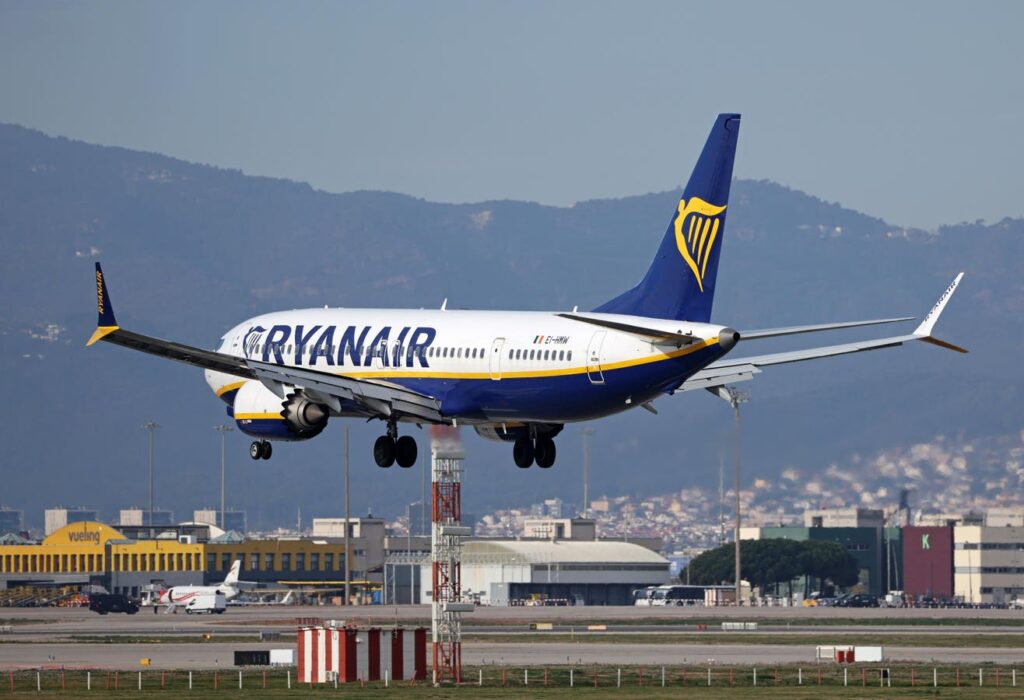A Boeing 737 MAX 8-200 from Ryanair lands at Barcelona-El Prat Airport in Barcelona, Spain, on … More
Ryanair’s CEO, Michael O’Leary, has warned that the airline will reassess its orders for up to 329 Boeing 737 MAX aircraft due to the added costs of tariffs imposed by the Trump administration. O’Leary toyed with the notion that the airline might acquire China’s COMAC C919 planes, though these are neither certified for the airline to fly nor available in the quantities necessary.
Responding to O’Leary’s speculative claim, U.S. representative Raja Krishnamoorthi warned that COMAC presents a security risk. Krishnamoorthi cited COMAC’s close ties to the Chinese military and speculated the manufacturer may have acquired intellectual property illegally to build its aircraft.
Ryanair’s CEO responded to Krishnamoorthi in a letter on Thursday, Ryanair pointing the finger directly at the cost-impact of President Donald Trump’s trade war.
“If the US government proceeds with its ill-judged plan to impose tariffs and if these tariffs materially affect the price of Boeing aircraft exports to Europe, then we would certainly reassess [Ryanair orders]
,” the Irish Independent quotes O’Leary as saying.
Ryanair Operates An All-Boeing Fleet
Ryanair operates an all-Boeing fleet of Boeing 737s, including 205 Boeing 737-800s and 119 Boeing 737 MAX 8s. The airline has ordered additional aircraft, including 29 737 MAX 8s, with the last delivery scheduled for March next year. Ryanair has also ordered 150 737 MAX 10s, with options for an additional 150 and deliveries planned over the next decade.
COMAC’s planes have not yet passed the European Union Aviation Safety Agency certification. While the manufacturer has been attempting to win over carriers in Southeast Asia, its current production rate is too low for COMAC to pose any serious threat to the Airbus and Boeing duopoly. Even if China can follow through on its promise to help COMAC reach a production rate of 150 aircraft per year by 2028, it will still lag far behind.
However, Boeing’s 737 MAX 10 is still pending FAA certification, so Ryanair could face delayed deliveries of its future aircraft regardless.
Low Aircraft Costs Are “Vital” To Ryanair’s Business Model
Ryanair’s main issue is to avoid an unsustainable price increase on the 737 MAX 8s it is due to take delivery of over the coming year. In the letter to the Congressman, O’Leary said keeping these costs low “is vital to our business model.”
Boeing delivered 105 737s during the first quarter of this year, representing a significant share of its 130 aircraft delivered in total and an improvement over the 67 units delivered in the first quarter of last year. The company is on the path to recovery from numerous complications and delays that followed the Alaska Airlines 737 MAX mid-exit door plug blowout last year. In its first quarter results, Boeing said it still plans to reach a 737 production rate of 38 units per month this year.
The U.S. manufacturer’s commercial aircraft division is still operating at a loss of $537 million for the quarter. However, this is better than the $1.14 billion loss reported through March of last year. Its current commercial aircraft order backlog is $460 billion.
A postponement of deliveries while the tariff dispute plays out would affect the airline’s capacity and Boeing’s revenue but might prove inevitable unless the Trump administration rethinks its current strategy to remove tariffs on new aircraft.
The trade war has already prompted China to forbid Chinese carriers from taking delivery of new Boeing planes and resulted in some aircraft enroute for delivery making a U-Turn to U.S. soil. The loss of scheduled deliveries to a major European customer is bound to hurt Boeing.
However, O’Leary said, “It is up to Boeing and the U.S. government to ensure that its great aircraft are competitively priced.”
These tariffs are impacting airlines and aircraft manufacturers on both sides of the pond, with U.S. airlines looking for creative ways to avoid the added costs and Airbus blankly stating it will not take on the burden.
Read the full article here
